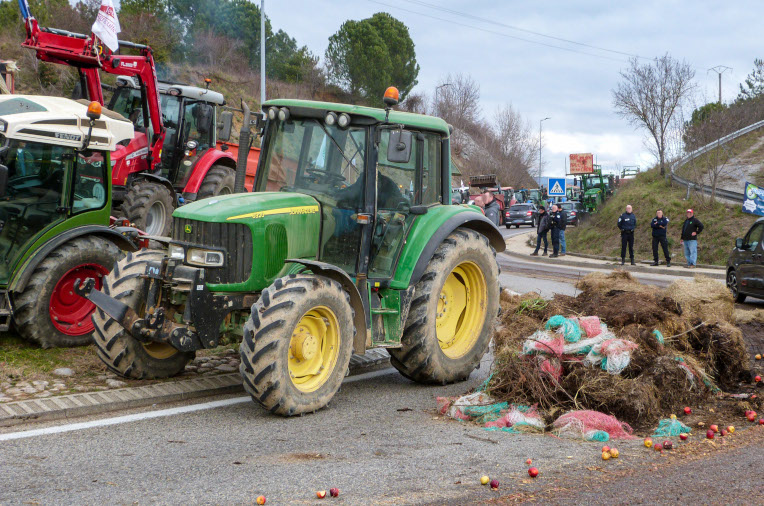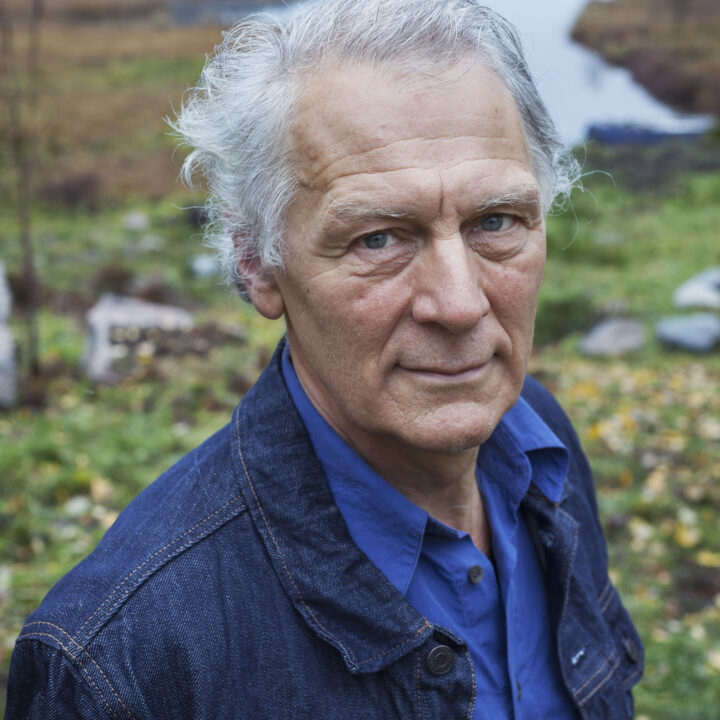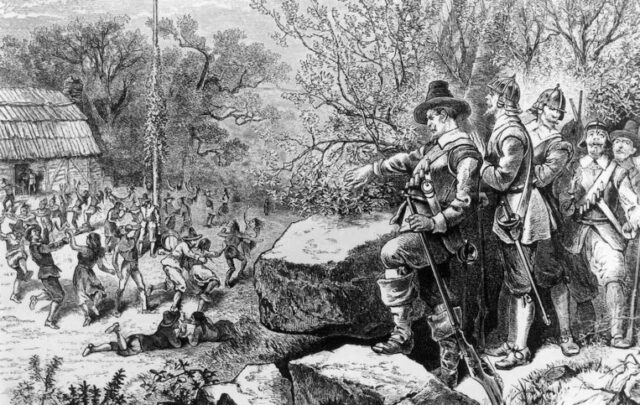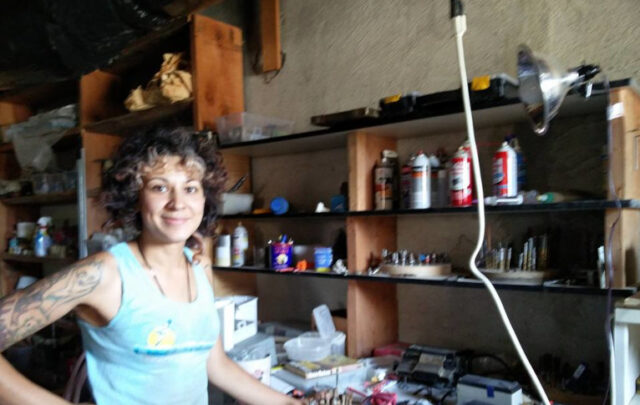Most have probably noticed that there have been massive protests by European farmers the last month. It started in Germany, linked to the budget crisis there, and later included farmers from France, Belgium, Portugal, Poland and several other countries. Of course, this is not the first and certainly not the last time that farmers will protest. Since 2019, there have been many protests in the Netherlands, something I covered in a recent article.
The protests have many different triggers. In the case of the Netherlands, nitrogen emission limitations has been the main issue, in Germany a diesel tax exemption that is threatened. In Eastern Europe the influx of grain, poultry and eggs from war-torn Ukraine is a major issue of contention. In France, unfair competition with other countries as well as stricter pesticide rules seem to be in focus. In Portugal farmers block border crossings to Spain, but I have not been able to clarify if that is a protest against imports from Spain or just a good place to stage a protest.
Political analysts link the farmer protests to a rise in right wing populism (see more below). The EU reacted rapidly with a number of measures to placate farmers. The mandatory 4% of the arable land that has to be allocated to biodiversity measures are suspended (again – it was the same last year for some other reason), there will be some restrictions on the imports from Ukraine, the plans to include agriculture in greenhouse gas emissions reduction plans is postponed and the plan to cut pesticide use in half has also been shelved.
The farm sector in Europe has been under a lot of pressure for a long time. The number of farmers are constantly shrinking. It is often discussed that farmers quit because it is not profitable to farm. But it would be too simplistic to say that the number of farmers are shrinking because it is not profitable to farm. By and large, the number of farmers are shrinking because the productivity per labor unit has increased tremendously and farms have grown bigger and bigger and bigger, so there has simply been no need for all those farmers. If some farmer will get more land and a bigger tractor, or manage more cows, on a system level it inevitably means that some other farmer will go out of business.
The anger of farmers is often directed to competition from other EU countries or from countries outside of the EU. One should, however, realize that much of the competition comes from within, where some economically efficient* farmers produce cheaper than their less efficient colleagues. That process is of course augmented with increased competition, so the EU internal market has sped up the consolidation and free trade agreements with other countries increase competition even more. After all this is just how textbook free markets are supposed to work. Most farmers are “just” producers of undifferentiated raw materials or commodities and have small possibilities to climb the value added ladder by making consumer ready products. For a few this can be an option for survival or, rarely, even for a thriving business.
With current policies the number of farms and people involved in agriculture is bound to decline
There is thus an underlying process of automation, consolidation, concentration and specialization in the agriculture sector which is “inevitable” in a market economy. That creates a constant pressure on farmers to rationalize their production, to cut costs or increase yields, mostly both. The number of farmers are bound to decline. In parallel, commercial farms are run more like any other business and are gradually moving away from being family farms with strong roots in the soil, the past, traditions and the rural communities. Many farm organizations and advisory services have been promoting this shift as well. Ironically, this means that farming as a lifestyle is reserved for (often wealthy) people with other income streams, or people living in relative poverty.
In parallel to this development, EU and members states have gradually strengthened environmental legislations in many ways. The present EU administration has set a new record of very ambitious environmental regulation within the frameworks of the Fit for 55 and the Green deal. In theory, most of the regulation are reasonable, or at least they have laudable aims. But the regulations fail to address underlying tensions and contradictions between continued economic growth and free markets on the one hand and care for the environment on the other hand:
The EU is generally pursuing a free trade agenda, even if less enthusiastic than a decade ago (global crises, the pandemic and Russia’s invasion of Ukraine are all contributing to a more reserved stance now compared to twenty years ago). Most free trade agreements will include improved access to EU food markets for the other parties. That is for instance the case with the deal with Mercosur that has been brewing for 20 years or so, described as a “cows for cars deal”. It will increase the competition pressure and gives farmers a fairly legitimate target for protests. A cornerstone for the EU project is the free trade between member states, or rather between all economic agents in the EU. This makes it illegal for a country to favor domestic production and even municipalities are in theory prevented from buying local food to the schools and hospitals as that breaks EU:s public procurement rules (quite a few municipalities have found creative ways around this, but that is another story). The purpose of all these neo-liberal policies is to intensify competition (which is called “fair competition”) and keep food prices low. Even the quite substantial support to the farm sector is translated into lower consumer prices, higher land prices and more rent income to banks, rather than higher farm income.
The EU and the member states constantly present new environmental regulations as win-win, pretending that there will be no substantial costs involved, or even net gain. The far reaching nature restoration law will allegedly cost EUR 154 billion but generates benefits valued at EUR 1,860 billion, according to the EU Commission. While I support nature restoration, regardless of its economic merits, I have my doubts about the calculations and in any case the benefits and the costs are not allocated symmetrically among actors. From the farmers’ perspective, a mandatory reduction of the use of fertilizers and pesticides, setting aside proportions of the land to bio-diversity, rewetting of peat soils etc. come with substantial costs. Despite being well intended, rules for animal welfare and food safety are also often increasing costs of production and in most cases proportionally more for small and diversified farms, increasing concentration even more.
The root problem is schizophrenic policies
These factors are clearly at odds. Most of the wealth in the modern world is created by the conversion of nature to things and ultimately to money, and it simply not possible to “save” or “protect” more nature without increasing cost or reducing production. But policy makers mostly refrain from acknowledging the underlying contradictions and present ambitious green deals or climate action plans while stating that they will make the country, or the EU, more competitive. That is hardly true in any sector and in particular not in farming. Which is why the anger is rightfully directed at them. Having said that, the analyses by the protesting farmers and their organizations are mostly not very profound and the protests are often directed against some symbolic increased cost or regulation (there are however some farm groups that have a more elaborated analysis).
It should be noted that also many other people are hit by the similar contradictions in the shape of increased energy prices or higher costs of living. Because of an ageing population, in general declining productivity in most sectors, and shrinking competitiveness in many of the more advanced economic sectors, the economies in the EU grow very slowly, which means that the ability of society to move problems into the future is much less than it was in earlier “stages of development”. People are no longer satisfied with the promise that things will only be better in the future – and probably they are right in this skepticism – the party is probably over. This is the reason for why many common people may sympathize with the farmers and why the populist right may benefit from these protests.
There are also cultural factors at play. Farmers and foresters are landscape managers. With the increasing urbanization and the limited number of people actively involved in farming or forestry, there is a general feeling by them that consumers, citizens and policy makers don’t understand the realities on the ground. International conventions, grand policies, public opinion, expert knowledge and scientific models trumps the skills and professional knowledge of those actually doing the job. This is a real problem because the rules imposed on farmers are often unrealistic and not sufficiently adjusted to local realities. It is also a cultural problem which makes farmers feel dominated by a largely urban elite or by what they see as urban environmental activists. Things are even worse, from the perspective of the farmers, when the same organizations not only criticize how they produce but also what they produce, most visible in the debate around livestock. Or when farm-free food is promoted as the way ahead, presenting farming as such both harmful and redundant.
Some also put the blame on consumers who are not willing to pay for good food. For sure, some blame can be attributed to them (you and me?), but by and large it is not the consumers that have turned the food system into what it is. Consumers never asked farmers to lock up the animals, grow monocultures, chop down trees and hedges and spraying pesticides. Not even organic food has been consumer driven in any wider sense. Consumers are not the customers of the farmers but farmers compete in selling to a very small number of ever larger food industries and retail chains. The notion of the consumer as the director of the food chain is a myth of the neo-liberal narrative. Unfortunately, farmers are often also fooled by this story and direct their anger towards the consumers for not supporting them by buying local (as if most farmers would buy local tractors, steel, furniture, shoes or even food….).
A new social contract for farming
I think the only way out of this predicament is to place farming and food production at the center and heart of the debate about the future of society – few people can dispute that food is the most essential production there is. It should be a starting point together with an acknowledgement of the need to protect other parts of nature and limit human dominance. In this vision, the role of agriculture is no longer to produce commodities for a competitive food market, but to manage agro-ecosystems in a sustainable (I really don’t like that word, but I guess you can understand what I mean) way to produce healthy food for the population. One could talk about a new social contract for farming. Exactly how that would pan out I can’t say** but I can see some directions it should take:
Relocalizing the food system, meaning that the majority (there will always be a need or desire for a certain trade from other areas) of the food consumed in any location would be locally sourced. This also means relocalizing diets as local conditions will result in a re-establishment of local diets instead of the increasingly globalized diets.
Get many more people engaged in farming and food processing and preparation. In most rich countries there are more people engaged in serving coffee in cafés than in farming. Instead of 1 percent of the population engaged in farming, it could be 10 percent (Greece) or perhaps 20 percent (Romania).
Re-distribute land to more people and give local communities more power over the management of the landscape from which they get most of their food. This could take many forms. There is a certain tension between those advocating a household based peasantry oriented to self-sufficiency (e.g. Chris Smaje) and those advocating a more commons based approach (I am leaning more towards this). I believe they could be complementary and not necessarily in any apparent conflict. Household units seem to be very persistent and resilient through human history or at least through the history of farming and why should you abandon something that works quite well?*. Nevertheless, those units have mostly been linked with many other units by the use of common resources (pastures, water, game, forest products etc.) and close cooperation etc. In the end, this might take different forms depending on the circumstances where also the agro-ecological conditions come into play and to what extent you share resources or not. Ultimately, I believe that the relationship between humans and the rest of the natural world is a question for all people and that all people in one way or the other should be involved in and have a say in how we interact with nature – and farming is clearly one of the main ways humanity is interacting with nature.
Parallel to this, we need to restore and further develop ecological literacy of farmers, foresters and others acting as landscape managers. Instead of being awarded for the highest yield of wheat or the cow that produce 20,000 liters of milk per year, farmers should be acknowledged and awarded for having a diverse and rich production system in something like harmony with nature (In reality there is no “harmony” or “balance” in nature as nature is dynamic, but I think you understand what I mean). This should also include an upgrade of farming as a profession.
That is all good, but what should we do NOW?
At the moment, I believe the question is how do we lead farmers, farms (fisheries and forests as well, but let’s keep the focus on the farms) and food in the right direction. Here I believe we need to work with three different tracks within the EU-context, keeping in mind that solution should contribute to a longer term vision, or at least not counteract it.
One track is to simply establish what you want to see in the future. Judging from other major shifts, this pulse will not come from within the farming sector. Even smaller changes, such as a transition to organic agriculture, have mostly been initiated by people from outside the sectors. Clearly this is already happening with thousands of grassroot initiatives. Most of my readers will already be familiar with them: CSA’s, Reko-rings, local food procurement, farm shops, collective urban farms, etc.
The other track is about reform of the farming sector in several way. Large scale farmers are fairly stuck, mentally, economically and structurally, in their reality here and now, especially industrial livestock farmers. If you have built a stable for 5,000 pigs you have very few options at hand. Here, it is actually hard to see any other alternative than buy-outs for closure. This is essentially what the Dutch government does to reduce nitrogen pressure and this is also what the Danish government has done with the mink farms. Both examples also show how difficult and contentious this can be. But the current policies has led to that 1,000 farms quit every day (!) and it continues to squeeze out farmers. Governments and the EU have historically paid “backward” or old farmers to quit, so there is nothing new with this. But obviously it has to be made in a socially responsible way. The restructuring of the large industrial livestock farms could open up new possibilities for other ways of farming.
For the rest of the sector we need to look at reforms that favors diversity, small scale food processing, direct marketing, or even better non-market distribution. Most of the budget of the CAP should be oriented to such measures instead of being a subsidy per hectare.
But we also need to limit competition, first from outside the EU and secondly also from within. The first step is to change procurement rules to make it perfectly legitimate for public institutions to purchase locally (interestingly, in the USA, local governments are exempt from the procurement rules of the WTO agreement). National or regional support to agriculture should also be possible. In the end, it would be better that the process of re-nationalization of EU farm policy continues as it brings power closer to those affected. This is also supporting the perspective of farming as landscape management and land as a commons. The common agriculture policy is originating from the perspective of food as commodities to be sold in competitive markets. In the long term, also environmental regulation would benefit from being brought closer to the people (possibly there could be some framework regulation on the EU lever for truly global issues such as climate change where goals could be set at the EU level, but all details of implementation is handled on national or local levels).
And the rest of the world?
I believe the situation in most rich countries as well as many middle income countries is quite similar to the situation in the EU, and can follow the same principles, even of details will differ.
The more difficult question is how to manage a transition – and a transition to what? – for the hundreds of million small scale farms and pastoralists in developing countries. I worked a lot with development assistance and small farmers over the years. In 2002-2008, I co-managed a very successful project for organic exports from Africa, EPOPA which gave more than 100,000 smallholder farmers access to global organic markets. That gave them a considerably higher income, and when people earn just a few hundred dollars per year that is good. But I got less and less convinced that integration into (unreliable) global markets is the best way ahead for small farm development. In the end, there will be a limited number of well-resourced farmers that will reap the benefits. Increasing exports of high-value crops mostly also means increasing imports of staple foods, which is a risky strategy and leads both farmers and countries away from self-determination.
By and large, I believe that small scale farmers in developing countries could benefit from the same principles as small scale farmers in richer countries, but the trajectory will be different. Some things will actually be easier. Most (but not all!) poor rural people are still relying on local food supply and mainly consume local foods. Having said that, I think it would be presumptuous by me to say I have a good answer to how the future of small scale farming in developing countries should look like – and it is not likely to be ONE path either as differences are great also within those developing countries.
Will food not become more expensive?
The short answer is Yes! But it is important to recognize that current food system is not sustainable and that if all external costs for health and environment were included, food would be much more expensive than today. Even with last years’ increase in food prices they are still very low in a historical perspective and even lower if you take into account the increase in income of most people. In the longer term food prices are also setting a floor for salaries, i.e. if food prices go up, salaries for so called “unskilled” labour will also go up. Clearly this doesn’t happen with sudden hikes in food prices which can be very problematic for the poor. Certainly there are groups, also in rich countries, that will need more support to afford food. In many poor countries, food prices are kept low through imports of cheap staple crops. That is perhaps beneficial for the urban poor, but it is also undermining the local farm economy and the whole rural economy. In any case, regulating food prices is not a particular effective social instrument, it is much better to direct efforts to those in need.
Will there be enough food?
We should recognize that the underlying trend in food production is oversupply, which is in turn driving down prices, driving up obesity and imbalanced nutrition as well as food waste (two years of food inflation have done more to reduce food waste in Sweden than ten years of public campaigns and a zillion projects). Some people argue that the industrial farms are needed to produce sufficient quantities of food, but the competitive edge of industrial farms is not that they are producing more per hectare than smaller farms but it is that they produce more per labor unit and that they have lower costs for labor, inputs, marketing, regulatory compliance etc. I expand on this here.
* It should be noted that “efficiency” is a dubious word as it always needs to be qualified as efficient in relationship to what. When I write “economically efficient” it just means “producing cheaper” with no consideration of external costs or whether it is efficient for bio-diversity, for rural development, for the well-being of farmers or livestock.
** There is a delicate balance between formulating visions for the future that are concrete enough to give direction and inspiration and plans that are prescribing details. In my view human societies will and should develop in an evolutionary way, with diversity, trial and error, compromises and trade-offs. Central planning and homogenous systems are bound to fail on many accounts.
*** Of course there have been many not so flattering tendencies in households/families, in particular patriarchy. But there have also been many not so flattering tendencies in collective management units. I believe the jury is still out regarding the question of an ideal economic/organizational unit for humans. Perhaps there isn’t one? Most likely it varies according to the circumstances.






